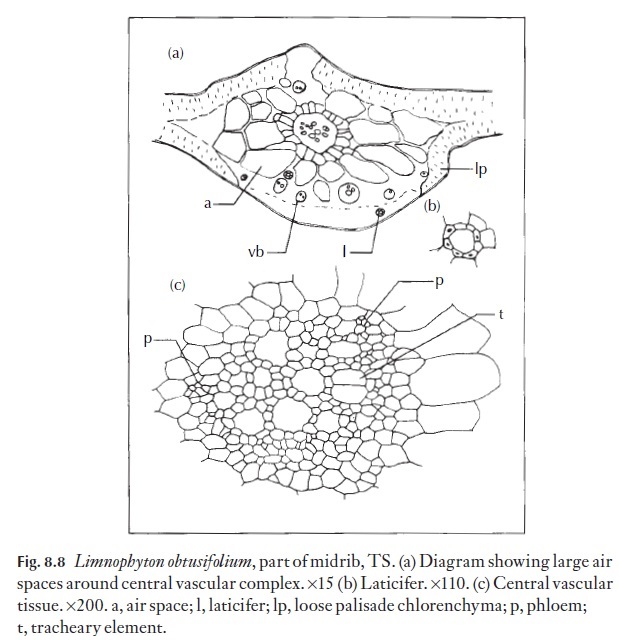Chapter: Plant Anatomy:An Applied Approach: Adaptive features
Hydrophytes
Hydrophytes
Hydrophytes, plants growing immersed in water or with the leaves floating and, perhaps, aerial inflorescences, show many anatomical features that clearly relate to their habitat, and in some instances family characters are so reduced as to be difficult to define.
Most stems and leaves have large air spaces between layers of internal tis-sues. These assist in buoyancy and also gas exchange. Many aquatic plants contain such buoyancy tanks.
The internal septa (walls bounding the air cavities), although multicellular, are often very thin. Individual cells in the septa are frequently star-like (stellate parenchyma), efficient in the use of materials, and allow gas flow from chamber to chamber. In bulrush, Typha, species, the upright leaves are divided into chambers similar in function to bulkheads in supertankers. They are an excellent example of economy of use of materials in producing a tall, mechanically strong structure. The up-right, flattened blades are twisted. This adds to their strength, and improves wind spillage, which reduces the impact and potential damage of strong winds. Buoyancy in floating aquatics may be achieved by using trapped air round the surface of the leaves, rather than by having air-filled chambers. Water lettuce, Pistia, for example, has a layer of closely arranged, hydro-phobic hairs on its upper surface making it difficult to wet or sink.
Cuticle is poorly developed or absent. Stomata are usually absent from submerged surfaces, and are often present on the upper surface of floating leaves. Vascular tissue, particularly xylem, is poorly developed and scleren-chyma is normally absent (Fig. 8.8).

Morphological adaptations include the reduction or absence of lamina or very linear leaf form in the submerged leaves of plants growing in running or tidal water, for example Zostera, Posidonia.
![]()
![]()
Plants growing in acid bogs have particular problems to overcome, par-ticularly since mineral concentration is low in the water, and the availability of nitrogen may become a serious problem. A number of plants from differ-ent families have developed anatomical features that help them to survive such conditions. Among these, the animal trapping (so-called ‘insectivo-rous’) plants are of particular interest. All have specialized glandular hairs on the leaf surface, for example Pinguicula, Drosera. These hairs may be of two types, stalked ones secreting very sticky substances which trap the victim, and the other, sessile, secreting digestive enzymes. The leaf gradu-ally rolls over to enclose the animal and opens out again when digestion and absorption is complete. Another, Dionaea, has sensitive trigger hairs on the lamina, three on either side of the midrib. The hairs are hinged at the base. They require two or three tactile stimuli to cause the leaf to fold shut vigor-ously. Marginal teeth mesh together, forming a prison from which the prey cannot escape. Reddish, glandular hairs then secrete digestive enzymes and absorption follows. Specialized hinge or motor cells are present along the midrib.
Related Topics